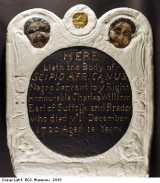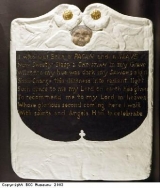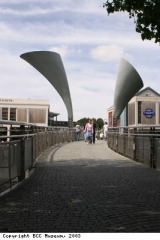Monuments to commemorate slavery
There are three references to the slave trade in the Bristol docks area. One is in a mural painted on a warehouse wall, listing the people and trades associated with the docks. Another is a small plaque on the wall of L Shed, one of the warehouses on Prince’s Wharf. The wording on the plaque reads:
In memory of the countless African men, women
and children whose enslavement and exploitation
brought so much prosperity to Bristol
through the African slave trade
Unveiled on 12 December 1997
during European year against racism
by Ian White
Member of the European Parliament for Bristol City Council
and Philippa Gregory
Author of ‘A Respectable Trade’
The third is the plaque beside Pero’s Bridge, a footbridge across the river named for a slave who lived and died in Bristol in the 1780s and ’90s.
Many people, especially young black Bristolians, would like to have the contribution their ancestors made to the prosperity of Bristol to be properly acknowledged. The suffering and sacrifice of enslaved Africans has never been adequately honoured. Artists Valda Jackson and Tony Forbes are just two Bristol artists who want to see a public statue of some sort in the city.
As one young Bristol filmmaker said, ‘We want somewhere to leave a flower’. At the moment, the grave of Scipio Africanus in Henbury churchyard serves this purpose. Scipio Africanus, whose real name we do not know, was servant to Charles William, Earl of Suffolk and Bindon, who married one of the Astry family of Henbury House. The black servant was named after an ancient Roman general of African origin, Scipio Africanus. The nick-name contrasts the servant’s lowly position as a slave with the status of the high-ranking Roman general of the same name. Scipio Africanus died in December 1720 at the age of 18. Little more is known about him. He might have been with the Earl for many years or only a few, we don’t know how long he had been in Henbury. Pictured here are the headstone and footstone for his grave. There are often flowers left on the grave of this young African slave. There have also been photographs left by the plaque on Pero’s Bridge. But these are individuals. The grave and the bridge do not stand as a proper memorial to the many thousands who were transported into slavery on Bristol slave ships.





